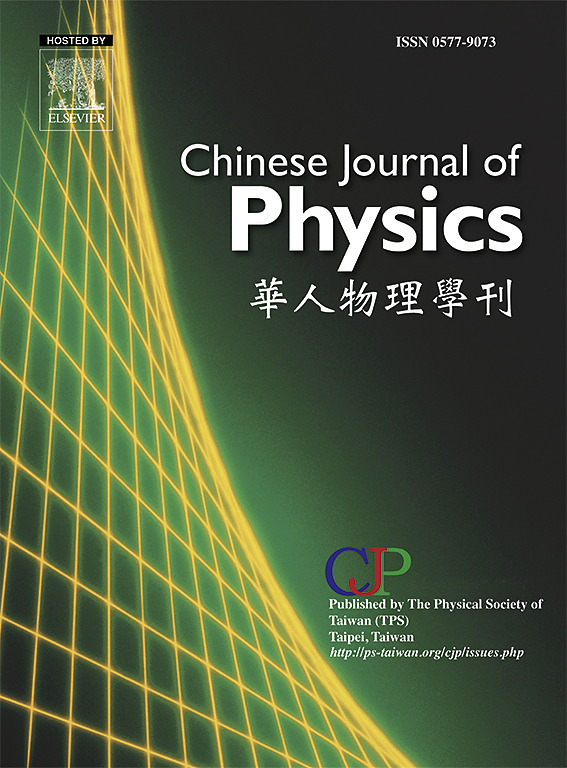线性f(Q)作用下无奇点各向异性致密星的带电类似物
IF 4.6
2区 物理与天体物理
Q1 PHYSICS, MULTIDISCIPLINARY
引用次数: 0
摘要
本研究在重力f(Q)理论的框架内模拟了球对称、各向异性、带电荷的致密恒星体的特征。采用Krori - Barua度量分析(K.D. Krori, J. Barua, J. Phys。答:数学。根据gen 8(1975) 508,结合f(Q)模型的线性形式,即f(Q)=α0+α1Q,我们得到了场方程的一组可处理的精确相对论解。电荷的一种特殊形式(q=q0r3)在这里被考虑用于本分析。结果表明,该模型在电荷强度q0≤0.0009Km−2时有效。超过这个值,模型就不能得到物理上可行的结果。我们得到了模型中的最佳拟合状态方程,并将其应用于TOV方程的数值求解,以确定本文所使用的参数空间内的质量-半径关系。随着电荷强度(q0)从0.0002增加到0.0009,最大质量范围为2.84 ~ 2.92 m⊙,半径范围为12.00 ~ 12.20 Km。此外,最近观测到的一些脉冲星和GW 190814的预测半径表明,我们的模型也符合根据观测结果估计的半径。我们的模型被发现满足所有的特征,如物质变量的行为、因果关系条件、能量约束和稳定性标准,这些特征与稳定恒星配置的背景有关,从而在f(Q)引力的框架下成为可行的和物理上可接受的恒星模型。本文章由计算机程序翻译,如有差异,请以英文原文为准。
Charged analogues of singularity-free anisotropic compact stars under linear f(Q)-action
This study simulates the characteristics of spherically symmetric, anisotropic compact stellar bodies with electrical charge within the framework of the theory of gravity. Employing the Krori–Barua metric ansatz (K.D. Krori, J. Barua, J. Phys. A: Math. Gen. 8 (1975) 508) along with a linear form of model, viz., , we obtain a tractable set of exact relativistic solutions of the field equations. A specific form of charge is considered here for the present analysis. It is noted that the model is valid up to the value of charge intensity . Beyond this value, the model does not permit physically viable results. We have obtained the best fit equation of state in the model, which is incorporated to solve the TOV equations numerically to determine the mass–radius relation within the parameter space used here. With increasing charge intensity from 0.0002 to 0.0009, the maximum mass ranges from 2.84–, and the corresponding radii range from 12.00–12.20 Km. Moreover, the predicted radii of some recently observed pulsars and GW 190814 show that our model also complies with the estimated radii based on the observational results. Our model is found to satisfy all the characteristic features, such as behaviour of matter variables, causality condition, energy constraints and stability criteria, which are pertinent in the context of a stable stellar configuration to emerge as a viable and physically acceptable stellar model in the framework of gravity.
求助全文
通过发布文献求助,成功后即可免费获取论文全文。
去求助
来源期刊

Chinese Journal of Physics
物理-物理:综合
CiteScore
8.50
自引率
10.00%
发文量
361
审稿时长
44 days
期刊介绍:
The Chinese Journal of Physics publishes important advances in various branches in physics, including statistical and biophysical physics, condensed matter physics, atomic/molecular physics, optics, particle physics and nuclear physics.
The editors welcome manuscripts on:
-General Physics: Statistical and Quantum Mechanics, etc.-
Gravitation and Astrophysics-
Elementary Particles and Fields-
Nuclear Physics-
Atomic, Molecular, and Optical Physics-
Quantum Information and Quantum Computation-
Fluid Dynamics, Nonlinear Dynamics, Chaos, and Complex Networks-
Plasma and Beam Physics-
Condensed Matter: Structure, etc.-
Condensed Matter: Electronic Properties, etc.-
Polymer, Soft Matter, Biological, and Interdisciplinary Physics.
CJP publishes regular research papers, feature articles and review papers.
 求助内容:
求助内容: 应助结果提醒方式:
应助结果提醒方式:


